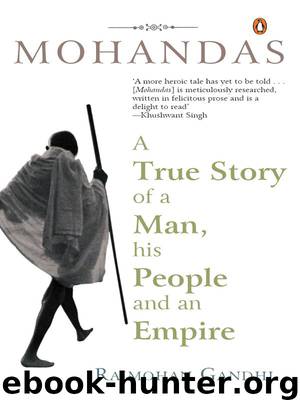Mohandas: True Story of a Man, His People by Gandhi Rajmohan

Author:Gandhi, Rajmohan [Gandhi, Rajmohan]
Language: eng
Format: epub, mobi
ISBN: 9788184753172
Publisher: Penguin Books Ltd
Published: 2007-10-09T00:00:00+00:00
Covering the RTC in London after having followed, for seven months, Gandhi’s doings and speaking in India, Shirer thought that this speech, delivered from the heart and without notes, was ‘the greatest one of his long political life’.67
Reaching out. Gandhi walked morning and evening along the streets of Bow, plied the spinning wheel daily in his ‘cell’, which had no table, chair or bed (he slept on the floor), prayed morning and evening in Kingsley Hall (where a goat was installed for Gandhi’s milk needs), and received callers in his cell.
Residents of Bow crowded their windows to stare at the strange figure walking past their homes. Hearing that they wanted to see him, Gandhi visited a woman in a hospital and a sick man in his home. Successfully badgering their parents, children joined Gandhi in his early morning walk. Muriel Lester observed that Gandhi ‘was delighted and took his walk with them, their rosy faces like apples, and big scarves round their necks’. The children called him Uncle Gandhi and ‘were sad to see he had no socks on and used to try to make him wear warmer clothes’.68
At a ‘joy night’ in Kingsley Hall, a woman called Martha Rollason patted Gandhi ‘on the shoulder’ and said, ‘Come on, Mr Gandhi, let’s have a dance.’ Muriel Lester thought Gandhi ‘looked awfully pleased to be asked’69 but he did not try to dance. At the Dorchester Hotel, the maitre, a man called Charles, greeted Gandhi, reminding him that they had taken dancing lessons together in 1889. Gandhi, who remembered, exclaimed, ‘Charlie!’
Assigned by Scotland Yard to protect Gandhi, Sergeants Evans and Rogers walked behind Gandhi and would ‘come back wiping their brow with sweat, trying to keep up with Mr Gandhi’.70 The two went wherever Gandhi went, and kept the long hours he did. Throwing himself into the life of Bow but also conferring, in hotels or chambers in London’s West End, with delegates and British leaders, Gandhi usually worked past midnight and slept, on an average, for about four hours a night.
The pattern of 1906 and 1909 was thus repeated. Much earlier, right after his student years, he had written in Guide to London that England’s climate was conducive to hard work.
To meet textile workers hurt by the Depression and by the Indian boycott of foreign cloth, he went to Lancashire for two days. Andrews (who brought himself to England for the Gandhi visit) had proposed this trip. Gandhi told the workers that he sympathized with them but asked them to think of Indian hardships as well. Following Gandhi to Lancashire, Shirer thought that ‘the bluff… cotton-mill hands’ gave one who had called for the boycott ‘a tumultuous welcome’.71
Gandhi also visited the Empire’s nurseries (Eton, Cambridge, Oxford) and its engines (Birmingham, Nottingham, Manchester). Finding his clothes, food and routine irresistible, journalists wrote many stories about him, which also, inevitably, touched on the Indian struggle. Though most large papers buried Gandhi’s remarks in small spaces on an inside page, the press stories
Download
Mohandas: True Story of a Man, His People by Gandhi Rajmohan.mobi
This site does not store any files on its server. We only index and link to content provided by other sites. Please contact the content providers to delete copyright contents if any and email us, we'll remove relevant links or contents immediately.
| Military | Political |
| Presidents & Heads of State | Religious |
| Rich & Famous | Royalty |
| Social Activists |
Waking Up in Heaven: A True Story of Brokenness, Heaven, and Life Again by McVea Crystal & Tresniowski Alex(37623)
Empire of the Sikhs by Patwant Singh(22912)
We're Going to Need More Wine by Gabrielle Union(18914)
Hans Sturm: A Soldier's Odyssey on the Eastern Front by Gordon Williamson(18437)
Leonardo da Vinci by Walter Isaacson(13114)
The Radium Girls by Kate Moore(11877)
Tools of Titans by Timothy Ferriss(8163)
Educated by Tara Westover(7890)
How to Be a Bawse: A Guide to Conquering Life by Lilly Singh(7349)
Permanent Record by Edward Snowden(5689)
The Last Black Unicorn by Tiffany Haddish(5532)
The Rise and Fall of Senator Joe McCarthy by James Cross Giblin(5177)
Promise Me, Dad by Joe Biden(5041)
The Wind in My Hair by Masih Alinejad(5014)
A Higher Loyalty: Truth, Lies, and Leadership by James Comey(4803)
The Crown by Robert Lacey(4695)
The Iron Duke by The Iron Duke(4258)
Joan of Arc by Mary Gordon(3987)
Stalin by Stephen Kotkin(3831)
